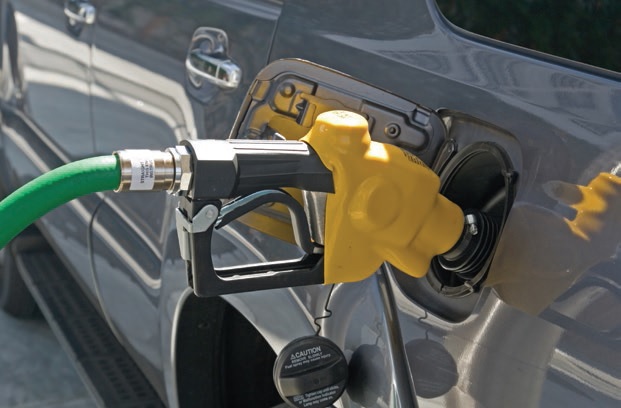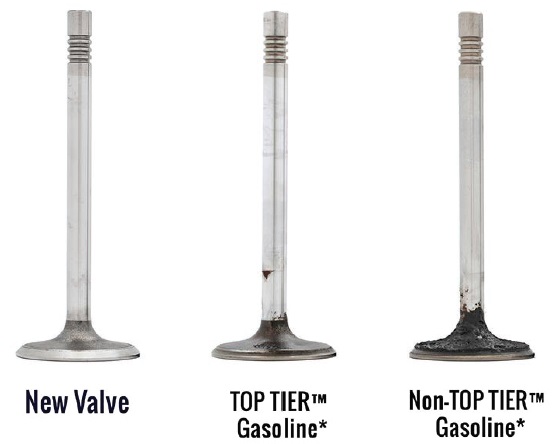Top Tier Gasoline
Dr. Edward P. Becker | TLT Automotive Tribology December 2017
Consumer Reports recommends them. Would your vehicle benefit?

© Can Stock Photo / cmcderm1
MUCH DISCUSSION HAS TAKEN PLACE since Consumer Reports magazine published an article (1) on Top Tier gasoline in the U.S. The article summarized a study conducted by the American Automobile Association (AAA) on six fuels, three of which were certified as Top Tier and three of which were not. Their basic conclusion was that most vehicles would benefit from the use of Top Tier fuel, whether the automaker recommends it or not.
The Top Tier certification is a cooperative project of multiple automakers who concluded that the level of detergent additives required by the U.S. Environmental Protection Agency (EPA) was insufficient to manage the deposits that form on critical engine components, in particular valves, fuel injectors and combustion chambers. The deposits themselves present an interesting tribological problem, as it is basically friction (or adhesion) that causes the deposits to stick. Also, buildup of deposits on valve stems can result in stuck valves again a frictional phenomenon.
To tackle this problem, the automakers decided not to specify additive types or levels but, rather, to require certain performance tests on fuels. Fuels that demonstrate a specified reduction in deposit formation can qualify for Top Tier certification. Generally speaking, Top Tier fuels have two to five times the detergent additive levels of the EPA standard fuels.
So does it work? According to AAA, the use of Top Tier fuels reduced intake valve deposits significantly (
see Figure 1). Stuck valves would probably be the most noticeable failure to a driver, as the loss of compression in the affected cylinders would be felt as a decrease in engine power. However, these deposits can be harmful in many other ways.
 Figure 1. Intake valve comparison showing a new valve compared to the results from the 100-hour engine test. (Figure courtesy of the American Automobile Association.)
Figure 1. Intake valve comparison showing a new valve compared to the results from the 100-hour engine test. (Figure courtesy of the American Automobile Association.)
Deposits inside the combustion chamber can act as an insulator, decreasing heat flow from the chamber into the coolant. While reducing heat loss in this way might seem beneficial to engine operation, in reality the decreased heat flow results in the deposits become quite hot themselves; sometimes so hot as to provide an additional source of ignition during the compression of the fuel-air mixture. Premature ignition results in a major loss of power and also can create an audible report usually described as
carbon knock. If allowed to continue, this type of pre-ignition can result in severe engine damage.
Deposits on the valves can cause other problems besides stuck valves. As the volume of the deposits grows, the area inside the intake port available for air flow is reduced. Very large deposits, therefore, can significantly reduce the peak power available by choking off the intake port. Also the deposits are generally porous, so in engines with port fuel injection, the deposits can absorb fuel that should be mixing with the air and going into the cylinder and resulting in a lean mixture, particularly after engine start-up when the environment is relatively cool. As the engine heats up, the absorbed fuel begins to evaporate, and the mixture goes from lean to rich. The relatively unpredictable nature of this absorption/evaporation behavior plays havoc with the engine control module as it tries to continuously adjust the fuel coming out of the injectors.
Should you be using Top Tier gasoline in your vehicle? As always, I recommend checking your owner’s manual and following the manufacturer’s advice. For example, my 2011 Chevrolet Malibu manual states, “To help keep the engine clean and maintain optimum vehicle performance, we recommend the use of gasoline advertised as TOP TIER Detergent Gasoline.”
REFERENCE
1.
Available
here.
 Ed Becker is an STLE Fellow and past president. He is president of Friction & Wear Solutions, LLC, in Brighton, Mich., and can be reached through his website at www.frictionandwearsolutions.com
Ed Becker is an STLE Fellow and past president. He is president of Friction & Wear Solutions, LLC, in Brighton, Mich., and can be reached through his website at www.frictionandwearsolutions.com.